Operations Analytics
Introduction
This section includes reports related to managing delivery, optimization, and performance of workloads.
| Report Group | Report Name | Report Description |
|---|---|---|
| Activity Analytics | Multi Cloud Activity | Consolidated list of Cloud activities from AWS, Azure. Helps you view all activities that happened and also slice and dice them by Resource Type, User etc. |
| Activity Analytics | AWS Activity | AWS Cloud activities. Helps you view all activities that happened and also slice and dice them by Resource Type, User etc. |
| Activity Analytics | Azure Activity | Azure Cloud activities. Helps you view all activities that happened and also slice and dice them by Resource Type, User etc. |
| Activity Analytics | GCP Activity | GCP Cloud activities. Helps you view all activities that happened and also slice and dice them by Resource Type, User etc. |
| Monitoring Reports | AWS Resource Health | Provides you the monitoring metrics for AWS resources. |
| Monitoring Reports | GCP Resource Health | Provides you the monitoring metrics for GCP resources. |
| Monitoring Analytics | AWS Monitoring Alerts | Provides list of monitoring alerts received for AWS accounts selected. |
| Monitoring Analytics | Azure Monitoring Alerts | Provides list of monitoring alerts received for Azure Subscriptions selected. |
| Monitoring Analytics | GCP Monitoring Alerts | Provides list of monitoring alerts received across all GCP projects selected. |
| Monitoring Analytics | Multi Cloud Monitoring Alerts | Provides consolidated list of monitoring alerts received across all AWS accounts and Azure Subscriptions selected. |
| Monitoring Analytics | AWS Utilization based on Metrics | Provides you the utilization of AWS resources based on the monitoring metrics. Helps you get a quick view of under-utilized and over-utilized resources. |
| Operations Governance | Operations Assessment Summary | CoreStack Operations Governance Assessment Summary. Read more about it in Visibility section above. |
| Operations Governance | Operations Assessment Detail Report | CoreStack Operations Governance Assessment Detail Report. Read more about it in Visibility section above. |
| Inventory Analytics | CloudOps Report | This report provides customers with insight into their cloud infrastructure's performance. |
| Operations Governance | AWS Cloud Manage Service Report | This Report is a comprehensive review of a customer's cloud infrastructure and operations. This report also includes details about architecture, security, compliance, and cost optimization. |
| Operations Governance | Azure Cloud Manage Service Report | This Report is a comprehensive review of a customer's cloud infrastructure and operations. This report also includes details about architecture, security, compliance, and cost optimization. |
| Monitoring Reports | OCI Resource Health | The OCI Health Report provides assessment details for resources related to OCI accounts. |
| Operations Governance | AWS Patch Management Report | The AWS Patch Management Report provides system information about the latest security patches and updates released by AWS. |
Note:
If SSM is installed by the user, then hostnames will be shown in AWS Backup Report and EC2 Backup Analytics, else hostnames are left empty in the report.
OCI Activity Reports
- Click Reports > Operations > OCI > OCI Activity. The OCI activity dashboard appears.
The report includes:
- Total Activities
- Succeeded Activities
- Failed Activities
- Provisioning Activities
- Deleted Activities
Cloud Operations Assessment Report
A CloudOps Assessment Report is a comprehensive review of a customer's cloud infrastructure and operations. This report also includes details about architecture, security, compliance, and cost optimization. This assessment report provides customers with actionable recommendations to improve their cloud operations, increase efficiency, and reduce costs while ensuring security and compliance.
The Cloud Operations Assessment Report provides the following details for Managed Service Providers (MSPs):
- Cloud activity
- Patch status
- Guardrail best practice recommendation
- Compliance control status
Note:
This report is currently available only for AWS and Azure cloud providers.
Perform the following steps to view Cloud Operations Assessment Report:
- In the CoreStack application, navigate to Reports > Global > Operations > AWS or Azure > Operations Governance > AWS Cloud Manage Service Report or Azure Cloud Manage Service Report.
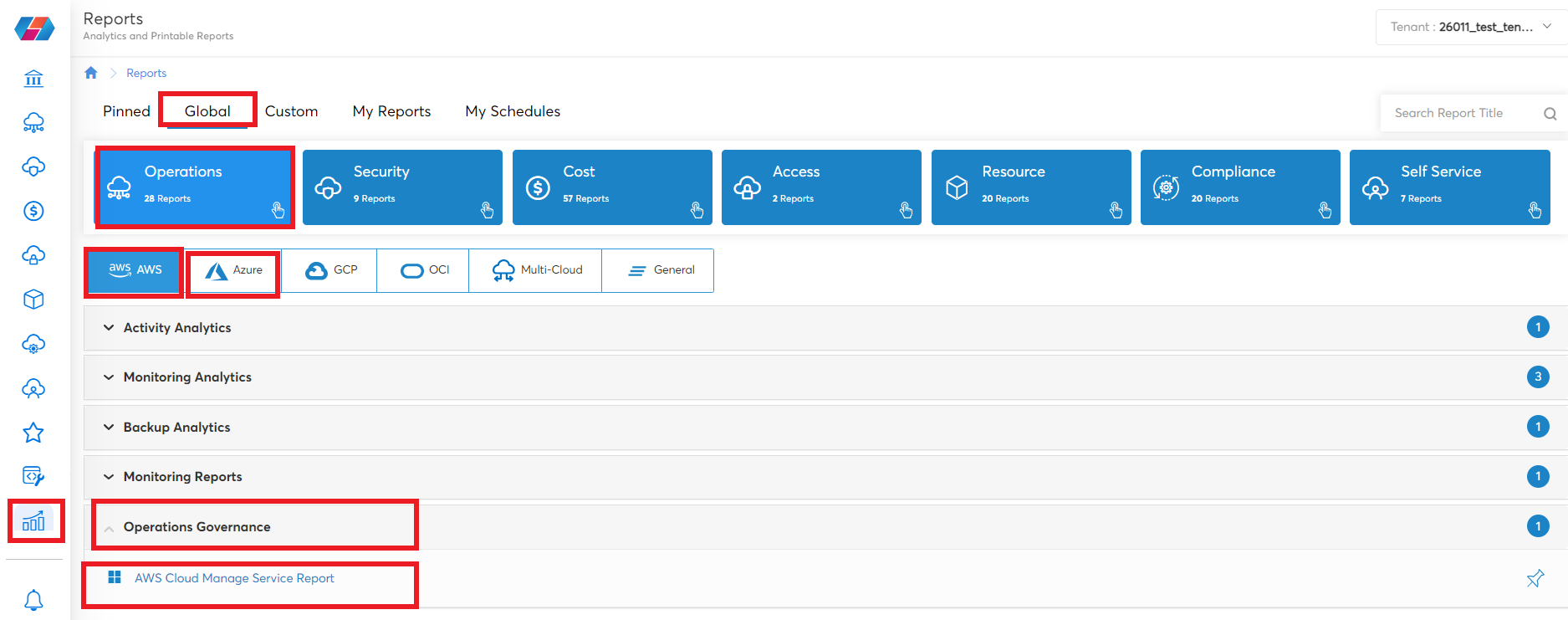
- In the Tenant list, click to select a tenant.
- In the Cloud Account list, click to select the cloud account.
- Click VIEW REPORT.
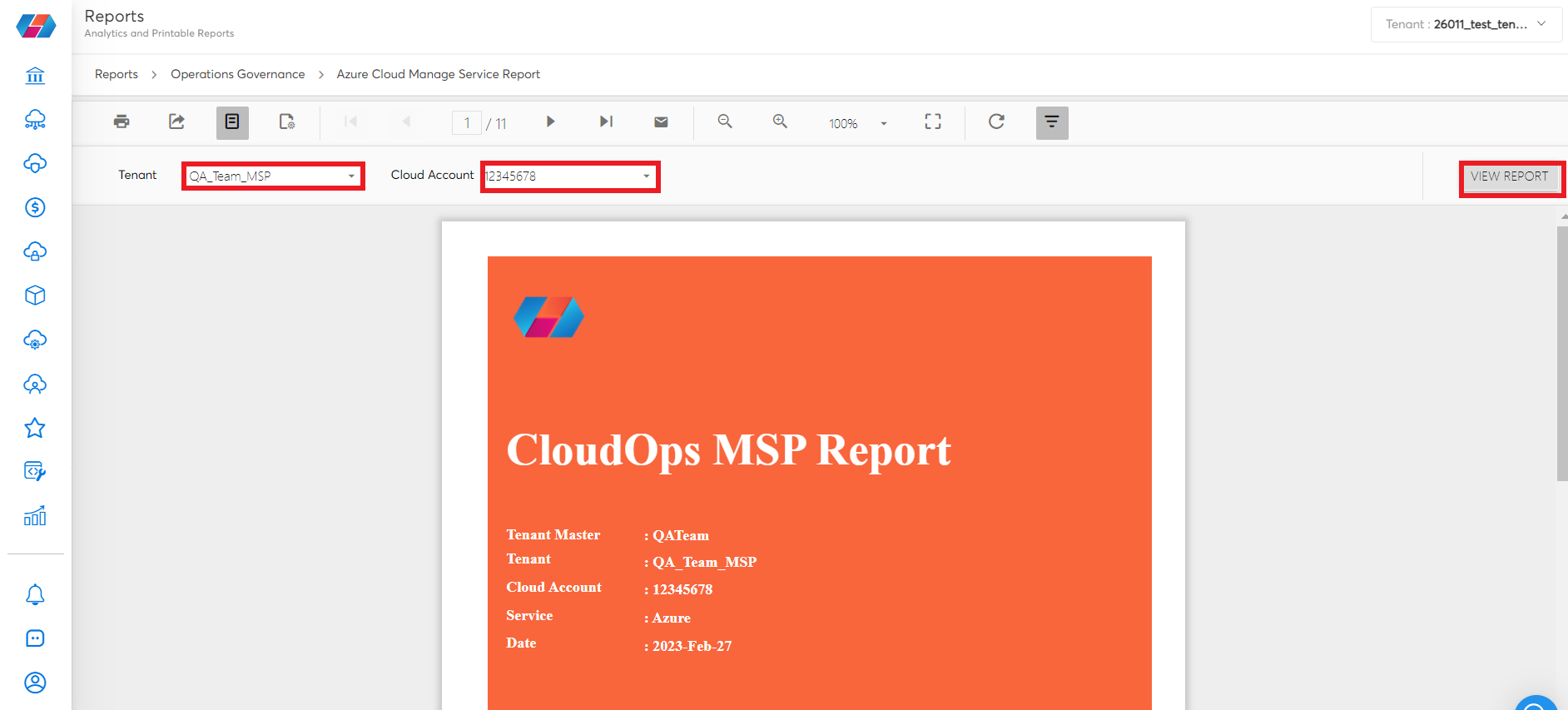
A user can view the following details in the report:
- Cost management: Cost spend over last 12 months.
- Cost visibility:
- Cost visibility by top resource type
- Last 6 months cost visibility for top resource types
- Cost visibility by top tag
- Last 6 months cost visibility for top tags
- Cost Saving Recommendation:
- Cost recommendation summary
- Cost recommendations
- Reservation recommendations
- Security trend:
- Security score
- Security update over last 12 months
- Threat overview
- Vulnerability overview
- Compliance control summary
- Resource utilization:
- Highly utilized virtual machines
- Low utilized virtual machines
- Top CPU-utilized VM costs
- Cloud assessment
- Backup summary
- Patch summary
OCI Health Report
The OCI Health Report provides assessment details for resources related to Oracle Cloud Infrastructure (OCI) accounts.
To view the OCI Health Report, perform the following steps:
- In the CoreStack application, navigate to Reports > Global > Operations > OCI > Monitoring Reports > OCI Resource Health.
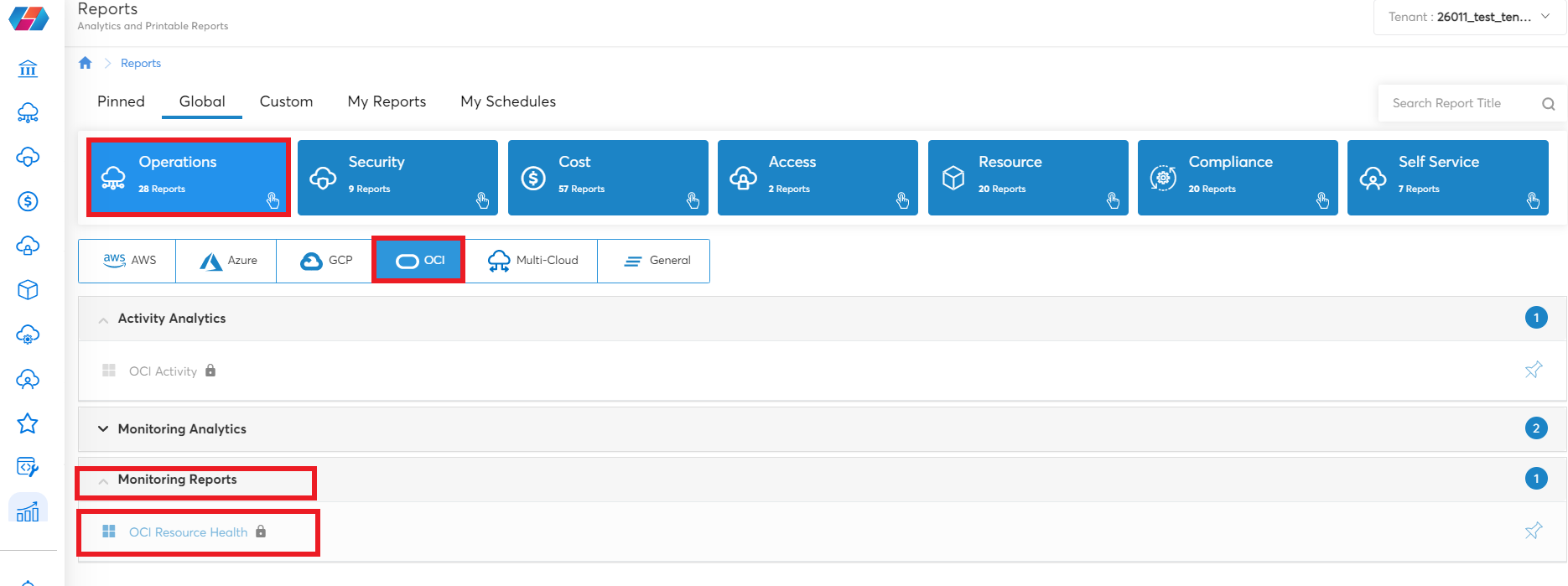
-
In the Tenant list, select the required tenants (Multiple options can be selected).
-
In the Cloud Account list, click to select the required cloud accounts (Multiple options can be selected).
-
Click VIEW REPORT.
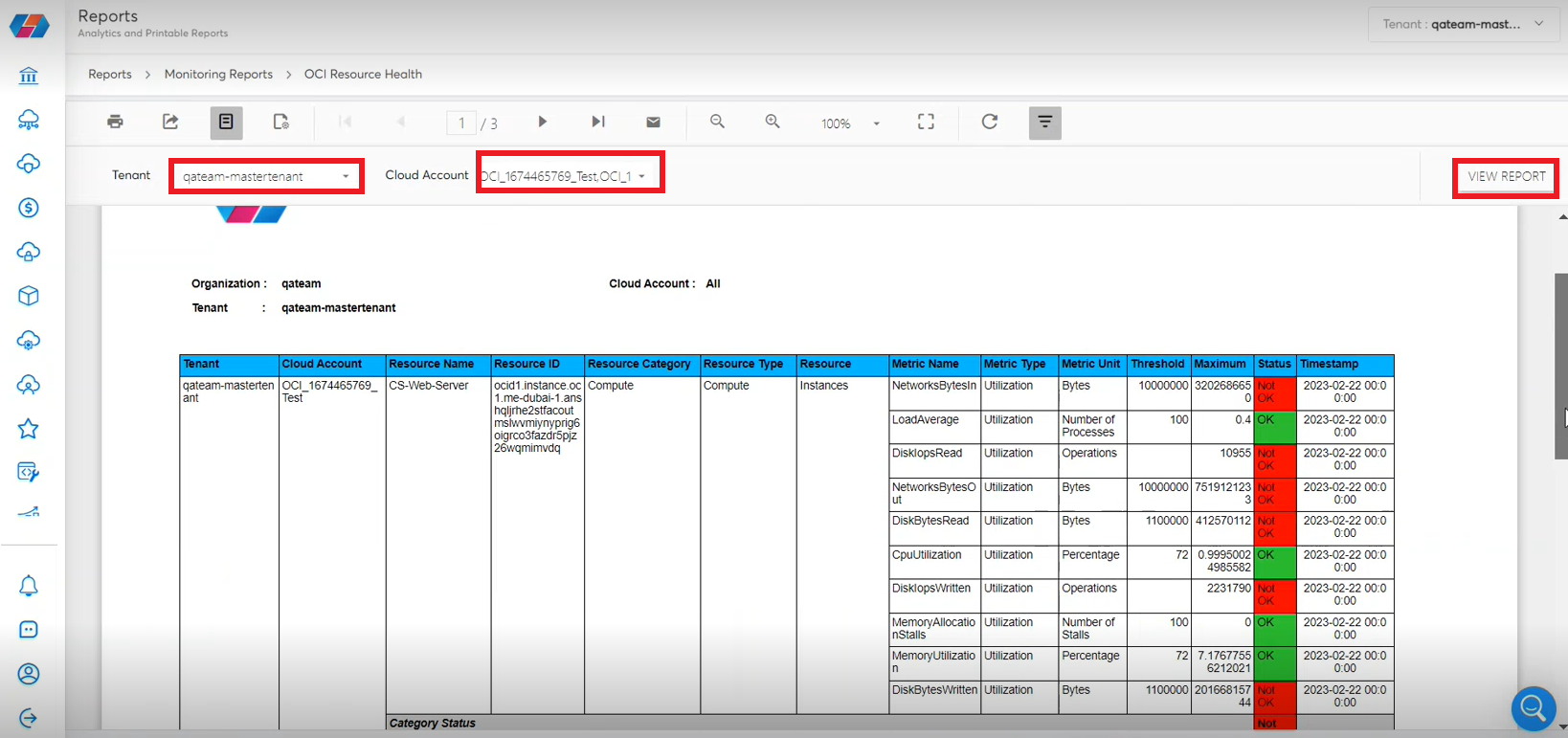
The report is generated in a PDF format and includes all resource related details for the past 72 hours. The Status column in the report shows the resource health as OK or Not OK. Users can export this report in PDF or Excel format.
Azure Patch Report
The Azure Patch Report shows the patch history of virtual machines by date. This report helps the user to view detailed information about various resources in the CoreStack application. CoreStack fetches all the patch details from the Azure cloud using Azure Log Analytics workspace.
Perform the following steps to view the Azure Patch Report:
- Access the CoreStack application and on the left vertical pane, click Reports.
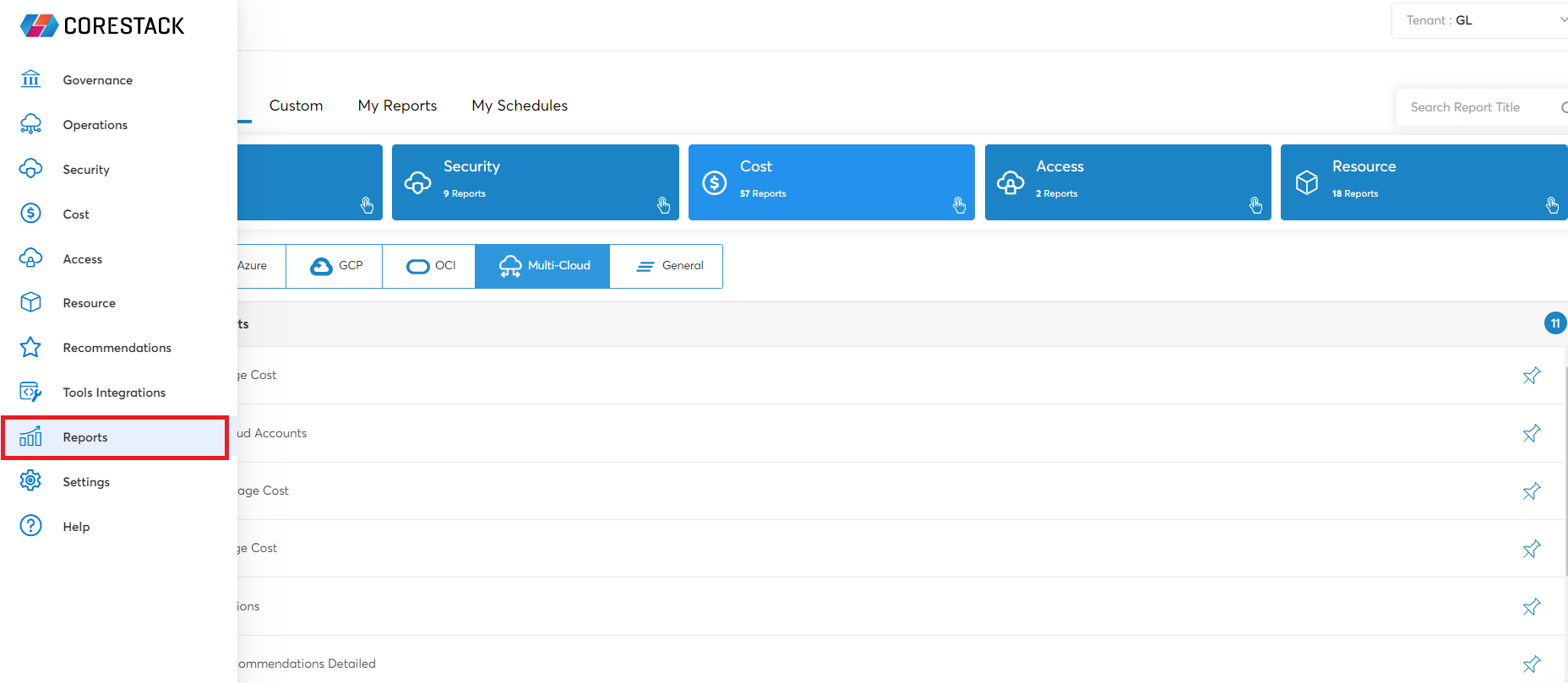
- Click Operations > Azure > Patch Management > Azure Patch Report.

By default, Present_Day is shown on the screen.
- On the right vertical Filter pane, select appropriate values from the following fields and click Apply.
- Resource: Select the resource names as per which you want to view the report.
- Workspace Name: Select the workspace names as per which you want to view the report.
- Cloud Accounts: Select the cloud account names as per which you want to view the report.
- Preset Value: Select the time period for which you want to view the report.
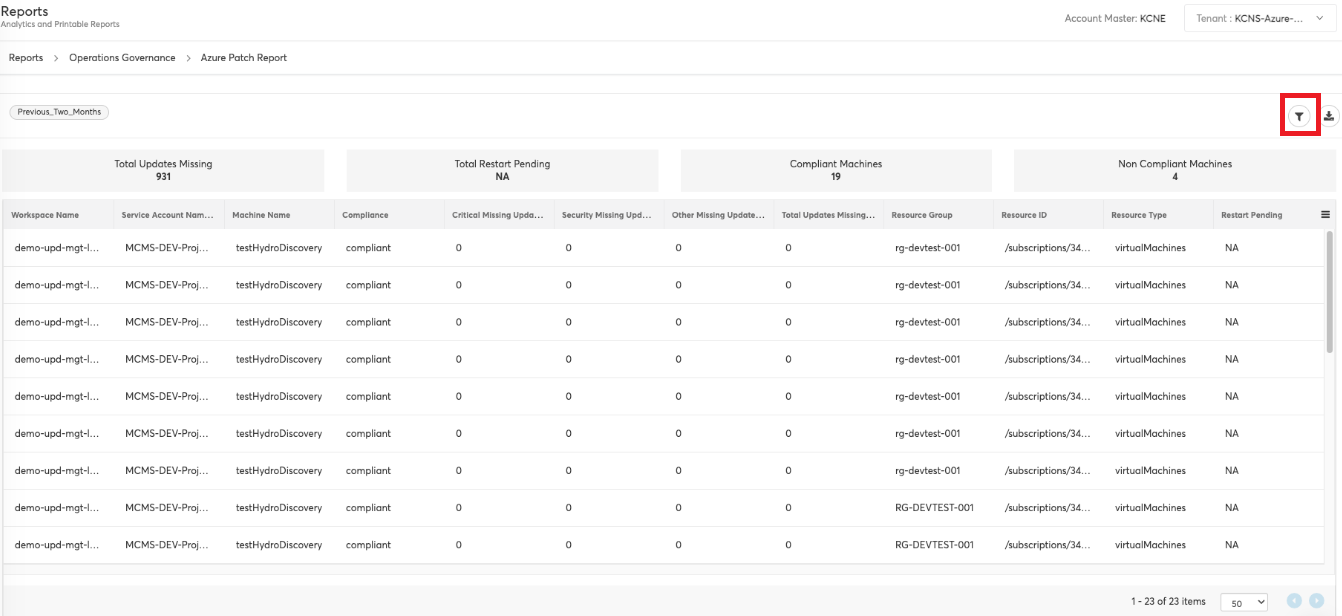
You will be able to view the report as per the selected options.
Note:
Click Reset to clear the options you have selected in Resource, Workspace Name, Cloud Accounts, and Preset Value fields.
The detailed report is shown as per the options selected in the Filter pane and you can view the crucial report summary in the following blocks on the top of the screen:
- Total Updates Missing
- Total Restart Pending
- Compliant Machines
- Non Compliant Machines
Note:
- Hover the mouse pointer over the Filter icon and click over it to view the Filter pane.
- To download a copy of the report, hover the mouse pointer over the Download icon and click it. Select the format in which you would like to view the report. You can view the report in one of these formats: JSON, PDF, CSV, or XML.
- To view additional columns in the report, click the three small horizontal lines on the extreme right side of the screen and select the column you would like to view in the report.
AWS Patch Management Report
The AWS Patch Management Report provides system information about the latest security patches and updates released by AWS. It includes information about security vulnerabilities, bug fixes, performance improvements, and new features introduced in each update.
This report typically includes details such as the patch ID, release date, description of the update, affected services, and the severity level of the vulnerability or issue being addressed.
Perform the following steps to generate the AWS Patch Management Report:
- Access the CoreStack application and on the left navigation pane, click Reports.

- Go to Operations > AWS > Patch Management > AWS Patch Management Report.
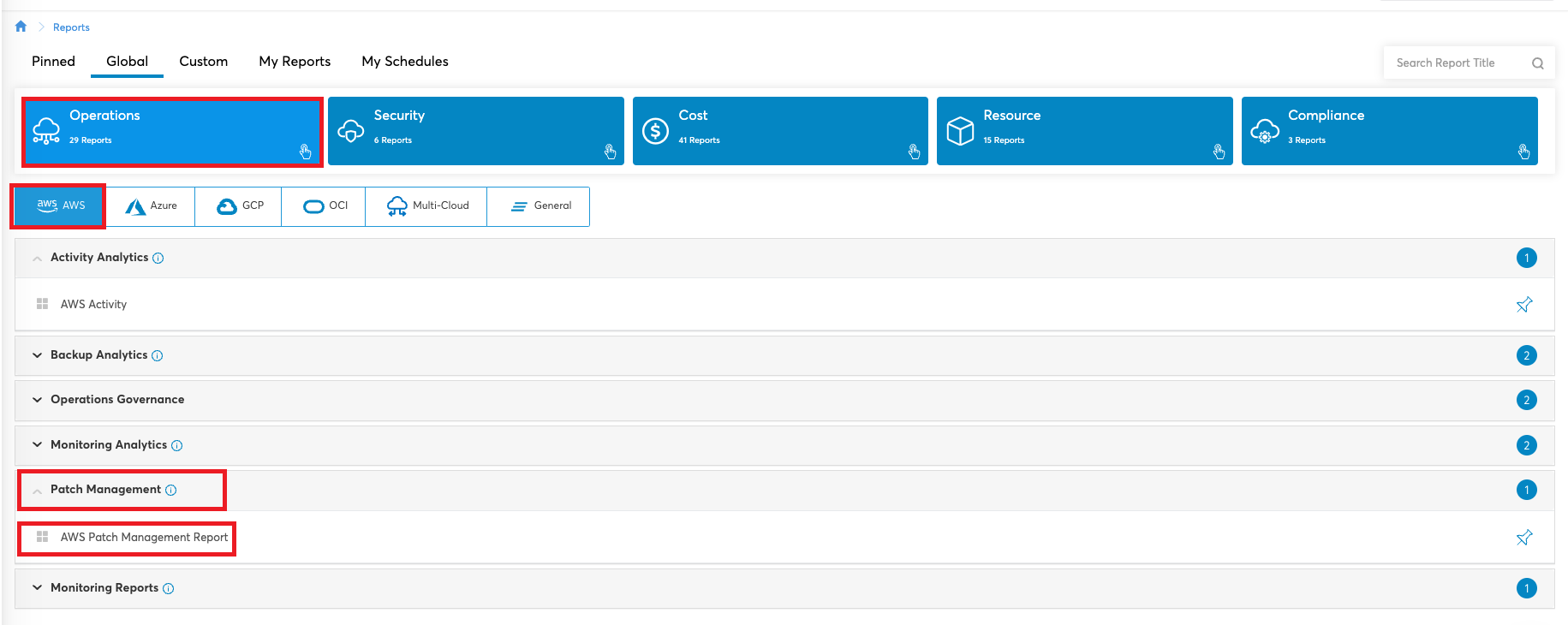
-
On the far right side of the screen, click the filter icon. The Filter pane opens.
-
Click the Preset Value field to expand it.
-
In the drop-down list, click to select one of the following time periods for which the report will be displayed, and click Apply.
- Current Month: This option shows the current month’s data (for example, Jun 01- Jun 12).
- Previous Month: This option shows the previous month’s data (for example, May 01 – May 31).
- Previous Two Months: This option shows the previous two months’ data (for example, Apr 01 – May 31).
- Present Day: This shows the data for the current day.
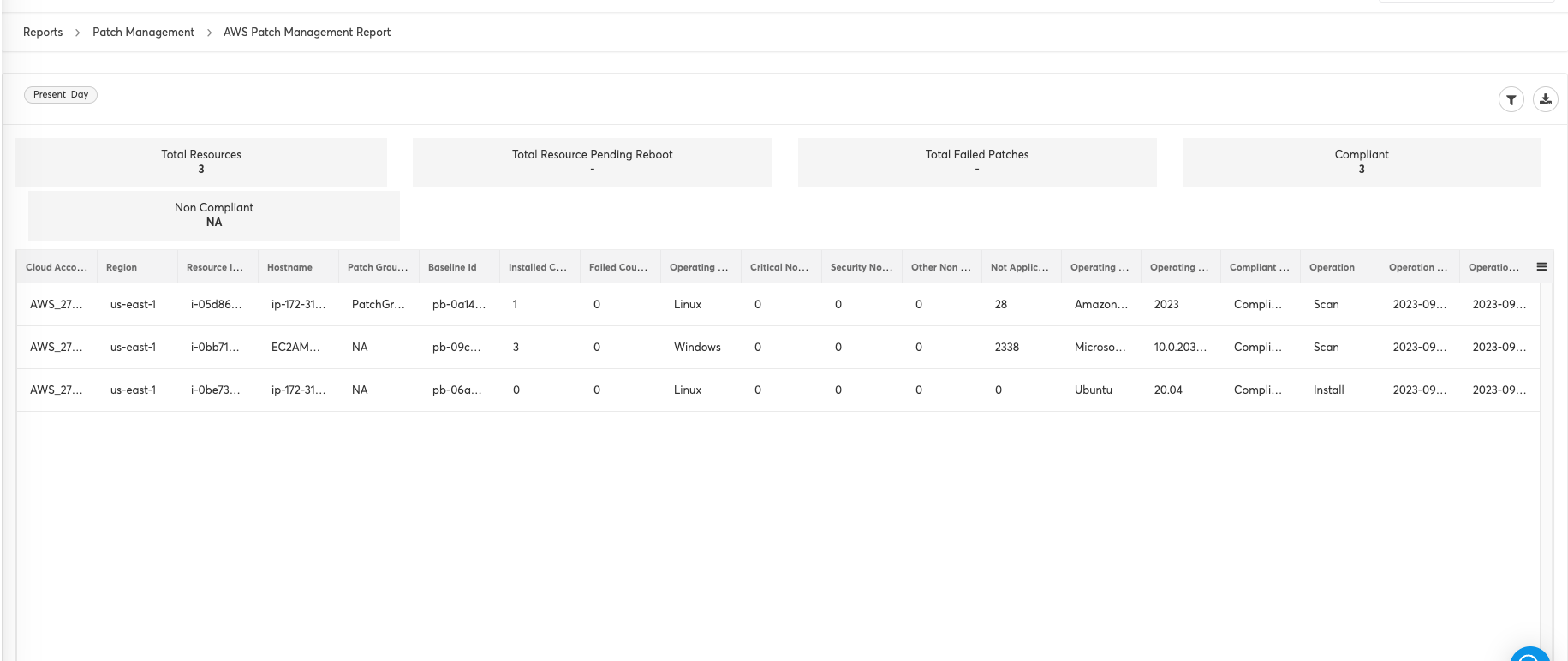
The report is now available and can be viewed in the CoreStack portal. Users can take any necessary actions after looking at the details in the report.
The AWS Patch Management Report can be generated in CSV, JSON, XML, and PDF formats. You can choose the format in which you would like to view the report.
This report provides details about service account name, region ID, resource ID, hostname, patch group, baseline ID, installed count, failed count, operation type, critical non-compliant count, security non-compliant count, other non-compliant count, unreported not applicable count, not applicable count, service account ID, operating system, and operating system version.
Updated 3 months ago